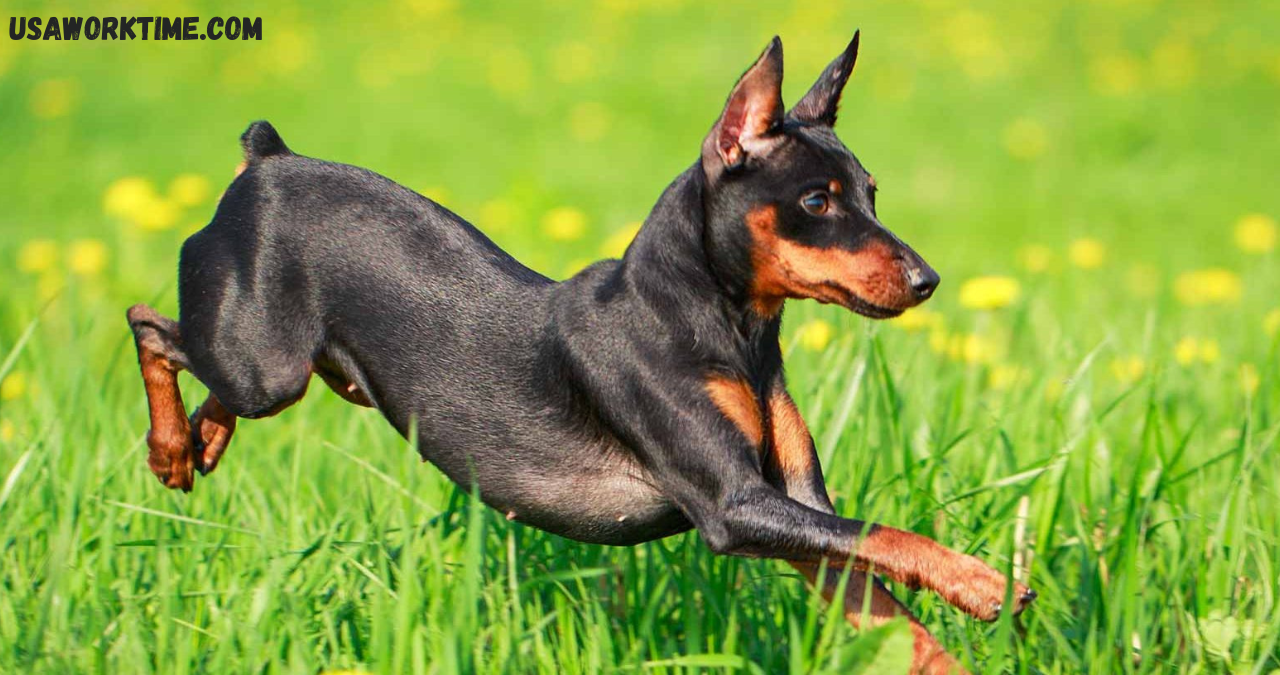The Miniature Pinscher (often affectionately called the “Min Pin”) is a small but mighty breed that packs a lot of personality into its compact frame. Known for its energetic nature, fierce independence, and unmistakable regal posture, this little dog has earned the nickname “King of the Toys.” With their boundless energy and confident attitude, Min Pin are not just small companions but also alert and determined watchdogs. However, despite their small stature, they often surprise people with their big-dog behavior. In this guide, we’ll explore everything you need to know about the Min Pin, from its history to its health and care requirements.
Origins and History of the Min Pin
The Miniature Pinscher has deep roots in German history, tracing its origins back to centuries ago. This breed was originally developed for a specific purpose: vermin control. Their ancestors were bred to hunt and eliminate rodents, particularly in barns and stables. Early Min Pin were likely a mix of breeds such as the Dachshund, Italian Greyhound, and the German Pinscher. These breeds contributed to the Min Pin sleek body, high energy, and alertness.
The Min Pin primary role as a vermin hunter and guard dog made it invaluable in homes, farms, and estates. As time went on, the breed gained popularity not just for its utility but also for its charming personality and bold demeanor. The breed was officially recognized by the American Kennel Club (AKC) in 1925, though it had already established itself as a prized companion in European countries. Their official classification as a toy breed was surprising to some, given their bold and confident demeanor, which more closely resembles that of larger dogs.
Physical Characteristics and Appearance
At first glance, the Miniature Pinscher’s appearance may suggest a regal breed, with its sleek, muscular frame and proud posture. This small dog stands between 10 to 12.5 inches tall at the shoulder and typically weighs between 8 to 12 pounds. Despite its small size, the Min Pin has a confident, almost larger-than-life presence. The body is compact and muscular, with a graceful gait that reflects its hunting lineage.
The Min Pin coat is short, smooth, and shiny, requiring minimal grooming. It comes in a variety of colors, including black and rust, chocolate, red, and blue. The characteristic rust-colored markings around the eyebrows, muzzle, and chest add to the breed’s striking appearance. One of the most distinguishing features of the Min Pin is its erect, triangle-shaped ears, which are often cropped for a more defined look but can also remain natural and floppy.
Though small, Min Pin are well-built dogs, displaying a combination of elegance and strength. Their tail, traditionally docked, is carried high, which enhances their alert and proud stance. Overall, the Min Pin appearance matches its bold and energetic personality, making it a visually impressive and beloved breed.
Personality and Temperament
The Miniature Pinscher is known for its larger-than-life personality, despite its small size. This breed is often described as bold, energetic, and fearless. It is not uncommon to see a Min Pin confidently strutting around like it owns the place, exhibiting behaviors typical of much larger breeds. The Min Pin temperament is what sets it apart from many other toy breeds. Unlike some small dogs that may be timid or overly dependent on their owners, the Min Pin is independent, brave, and often quite stubborn.
Despite their strong personalities, Min Pin are loyal to their families. They bond closely with their owners and are often protective, making them excellent watchdogs. However, they can also be wary of strangers and tend to bark loudly to alert their owners of anything unusual. Min Pin are not typically aggressive, but their protective instincts can sometimes be mistaken for dominance, particularly in their interactions with other dogs or unfamiliar people.
Socialization is key for a Min Pin to grow into a well-adjusted dog. Without proper exposure to different environments, people, and animals from an early age, they may become overly cautious or territorial. Training can also be a challenge because of their independent nature. These dogs are intelligent, but they have their own ideas about what’s worth listening to, so consistency and patience are required in their training.
Training and Exercise Requirements
Training a Miniature Pinscher requires patience, consistency, and a firm hand. As highly intelligent dogs, Min Pin are quick to learn commands, but they also tend to be quite independent and occasionally stubborn. They may challenge their owner’s authority, especially if they sense a lack of confidence. Early training and socialization are vital to help them grow into well-behaved, balanced pets. Positive reinforcement, such as treats and praise, works best for this breed.
Min Pin are highly energetic dogs that need regular physical and mental stimulation. Without proper exercise, they can become bored and develop undesirable behaviors, such as excessive barking or destructive chewing. Ideally, Min Pin need at least 30 minutes to an hour of exercise each day. This can include walks, playtime in a secure yard, or even more active pursuits like agility training. Their strong prey drive may also lead them to chase small animals, so supervision is essential during outdoor activities.
While Min Pin are active and playful, they can also be prone to short bursts of high-energy behavior, often referred to as “zoomies.” These rapid spurts of running around the house are typical of the breed and reflect their playful, sometimes mischievous nature. Mental stimulation through puzzle toys or obedience training can also help curb any excess energy and prevent boredom.
Health and Care Essentials
Like all breeds, the Miniature Pinscher is susceptible to certain health issues. The most common conditions in Min Pin include patellar luxation (a dislocated kneecap), Legg-Calvé-Perthes disease (a hip joint disorder), and dental problems due to their small mouths. Regular veterinary check-ups and preventive care can help catch and address any issues early. Min Pin also tend to have delicate skin, which means they should be protected from harsh weather conditions, especially cold temperatures.
The Min Pin coat is low-maintenance, but regular brushing can help keep it looking shiny and healthy. Brushing also helps reduce shedding, which is minimal compared to other breeds. Their nails should be trimmed regularly, and their ears should be cleaned to prevent infections, especially if they are cropped. While Min Pin don’t require frequent bathing, occasional baths are necessary to keep them clean and comfortable.
Nutrition is another important aspect of caring for a Min Pin. Because of their small size, they require a high-quality diet formulated for toy breeds. It’s essential to feed them the right amount to maintain a healthy weight and prevent obesity, which can lead to joint problems. Offering a well-balanced diet, rich in protein and nutrients, will support their high energy levels and overall health.
Living with a Min Pin Lifestyle and Adaptability
Min Pin are highly adaptable, which makes them suitable for various living situations. Whether you live in a small apartment or a large house with a yard, a Min Pin can thrive as long as its exercise and socialization needs are met. However, they are better suited to homes where they receive consistent attention and mental stimulation. They may not do well in households where they are left alone for long periods, as they are prone to separation anxiety and can become destructive when bored.
Although they are small, Min Pin can be somewhat delicate. They tend to feel the cold more acutely than larger dogs, so they should be kept warm during chilly weather. When outside, it’s essential to ensure they are protected from extreme temperatures, either by bringing them indoors or outfitting them in doggy sweaters. When it comes to traveling, Min Pin are relatively easy to take along. They are often good in cars and can adapt to traveling as long as they feel safe and secure.
This breed also enjoys companionship and is known to be affectionate with family members. However, they are not the best choice for households with young children due to their small size and delicate nature. They may tolerate older children who understand how to treat small dogs, but they can get nippy if provoked.
Min Pin Myths vs. Facts
One of the biggest misconceptions about the Miniature Pinscher is that it is simply a “miniature Doberman.” While both breeds share some physical similarities, the Min Pin is a distinct breed with its own history and traits. Unlike the Doberman, which was originally bred for protection and law enforcement, the Min Pin was created for vermin hunting and companionship.
Another myth is that Min Pin are aggressive or difficult to train. While they are confident and sometimes stubborn, they are not inherently aggressive. With proper training and socialization, Min Pin can become well-behaved and loving companions. They are also not as fragile as some may think. Though small, they are sturdy dogs with a lot of energy and resilience.
Conclusion
The Miniature Pinscher is a remarkable breed known for its bold personality, high energy, and independence. While they may require extra attention when it comes to training and exercise, their loyalty, intelligence, and affectionate nature make them wonderful companions for the right owner. If you’re considering adding a Min Pin to your family, it’s essential to understand their unique needs, from exercise requirements to grooming and training. With the right care, the Min Pin can be a joyful and energetic addition to any household.
Frequently Asked Questions (FAQs)
Is a Min Pin the same as a miniature Doberman?
No, they are different breeds. While they share a similar appearance, the Min Pin is not a mini version of the Doberman and has a distinct history and temperament.
Are Miniature Pinschers good for first-time dog owners?
Min Pin can be challenging for first-time owners due to their independent nature and stubbornness. They require patience, consistency, and proper training.
How much exercise does a Min Pin need daily?
Min Pin need at least 30 minutes to an hour of exercise each day to stay healthy and burn off energy.
Do Min Pin shed a lot?
Min Pin shed minimally due to their short, smooth coat, making grooming relatively low-maintenance.
Can a Miniature Pinscher live comfortably in an apartment?
Yes, Min Pin can adapt to apartment living as long as they get enough exercise and mental stimulation.
You May Also Read: https://usaworktime.com/






